Adding a battery to your solar home can reduce your bills and keep your lights on if there’s a blackout.
But choosing one for your home isn’t as simple as popping down to the shops and getting some AAs.
I recently released the 2024 edition of my plain English video guide to batteries. It has all the info you need to buy batteries with confidence.
If videos aren’t your cup of tea – here’s a summary:
What Do Batteries Cost?
Expect to pay about $10,000 before installation for a 10 kWh battery.
Name-brand batteries, like Tesla’s Powerwall, will naturally cost more than some no-name batteries out of China, kWh for kWh.
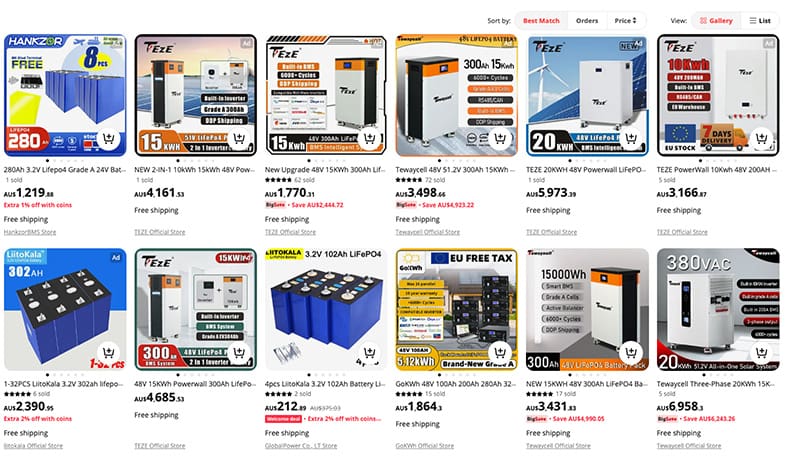
My advice? Don’t buy a battery from AliExpress!
Straight-forward installs will set you back about $1,500. If you have a tricky install, with long cable runs or extra components (like bollards) needed, this will be closer to $3,000.
I’ve got a table where you can compare all the major battery brands available in Australia, including their pricing.
What brands can you trust?
Our battery comparison (linked above) has heaps of batteries. Which ones would I recommend to my mum?
Any of these:
Personally, I own a Tesla Powerwall and a Sungrow home battery. The Powerwall is on my family home and is connected to the Tesla VPP, and cycles more than once per day. I get a modest monthly bill from Tesla for my all electric house and 2 EVs. The Sungrow (on a rental unit) is on a regular AGL tariff and has never seen a positive electricity bill.
How Long Do Batteries Take To Pay For Themselves?
My solar and battery calculator can crunch the numbers for your situation. My “Add a battery” calculator shows you potential savings of adding a battery to your existing solar panel system.
But generally, payback is lame on a flat electricity tariff but can be attractive on a time-of-use tariff:
Best-case payback scenarios assume you’ll fully charge your battery from solar during the day and fully discharge it during peak grid pricing periods (for maximum savings) every day of the year.
Are There Any Battery Rebates?
Sadly, unlike for solar, there is no federal battery rebate.
If you’re in the NT, you can get up to $5000 from the territory government.
While not rebates, Victoria and the ACT have interest-free loans to take the sting out of dropping thousands upfront.
Certain Virtual Power Plants (VPPs) offer up-front discounts if you buy a battery directly from them or bring your own.
Batteries and Backup
Most people believe having a battery means their house is backed up in a blackout.
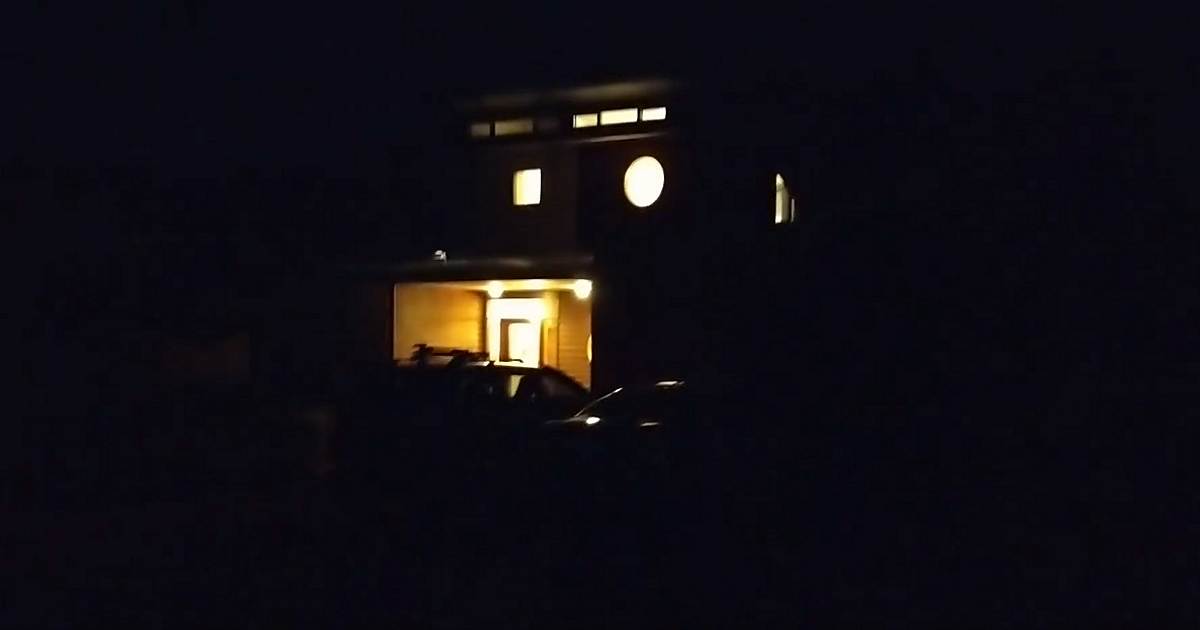
My place as the only beacon of light on a blacked-out street
The reality depends on the specific battery you’re using.
Some, like the Powerwall, will back up your whole house by default. Others can only handle backing up certain nominated circuits.
Some batteries may not even offer any blackout protection.
It’s up to your installer to understand your requirements and offer a suitable system.
My advice? Only backup essentials like lights, fridge, and living room (including internet router). You don’t want a large load (like an oven) tripping your battery on power or draining it of energy and leaving you in the dark.
Why Do Most Batteries Use Lithium-ion?
No other battery chemistry comes close to beating lithium-ion’s performance, size, efficiency, and ease of maintenance while remaining competitive in price.
This is why virtually every battery on the market uses some variant of lithium-ion.
There are 3 major lithium-ion variants in batteries sold in Australia: NMC, LFP and LTO.
LTO has the highest performance, lifespan and safety but is rare and expensive.
NMC and LFP are far more common, with LFP having an edge over NMC regarding safety – albeit marginal, as all batteries sold in Australia have to meet high safety standards.
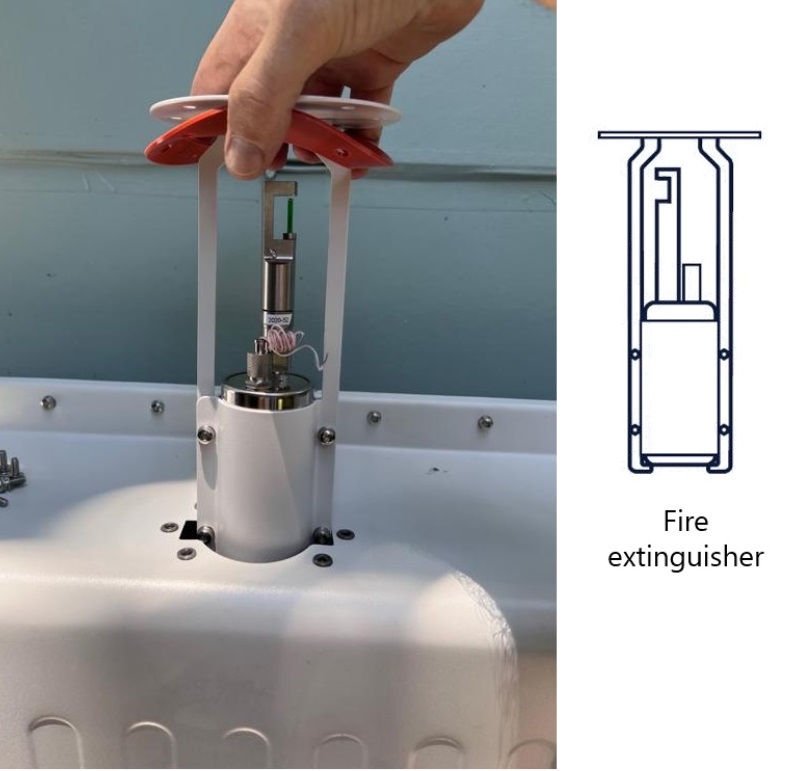
Fun fact – the SolarEdge battery has an optional, built-in fire extinguisher.
My battery comparison table lists the specific chemistry used by each battery.
What Will Batteries Look Like On Your Home?
Batteries look slick in their marketing materials:
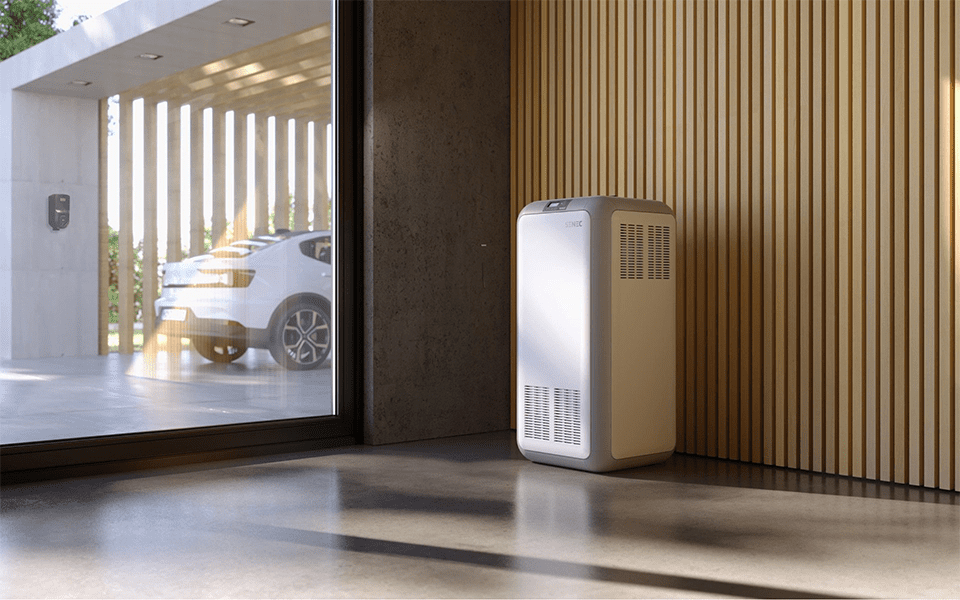
Slick. Futuristic. Location may not be compliant with Australian standards.
But the reality is less sexy – you’ll need isolating switches, power, comms cables, warning stickers and – if in a garage – a bollard.
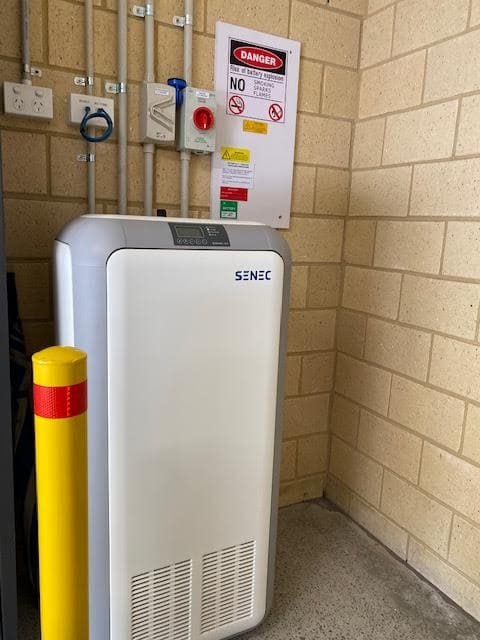
Compliant installations don’t make the best brochure shots.
Dealing With Dodgy Battery Salespeople
My advice here is simple:
- Don’t buy a battery (or anything, really) from doorknocking salespeople
- Don’t buy a battery from unsolicited sales letters in the mail

Show him the door!
Buying from either of the above gives you a high chance of ending up with an overpriced, undersized battery that doesn’t fit your needs.
Battery Warranties – What to Watch Out For
The key question is whether your chosen battery manufacturer has an Australian office for warranty support.
Many companies have started to import and sell batteries from overseas.
There’s nothing wrong with this. But how likely is it a small importer will be around over the next 10 years, ready and willing to assist you or your installer with any issues?
The Next Step
If you are hungry for even more info about batteries or solar – everything you could ever want to know is on my website. It has everything you need to research batteries, from reviews of solar installers and hardware to payback calculators and tools to help you find a better feed-in tariff.
And when you’re ready to take the next step, I’d be happy to arrange quotes from my network of about 500 vetted solar installers across Australia.

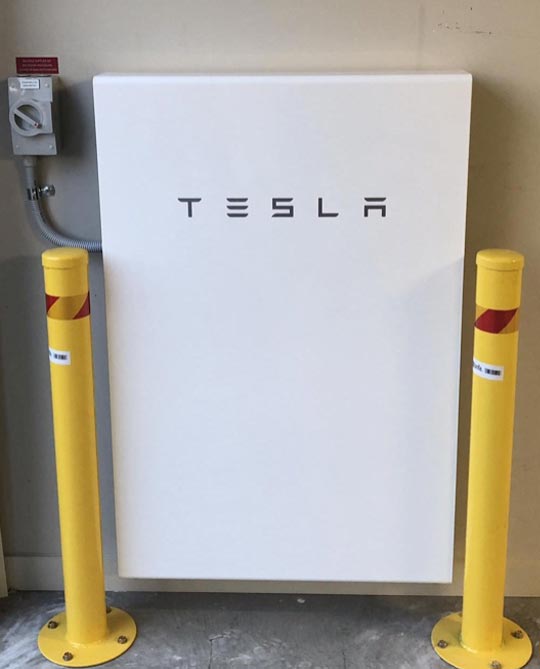
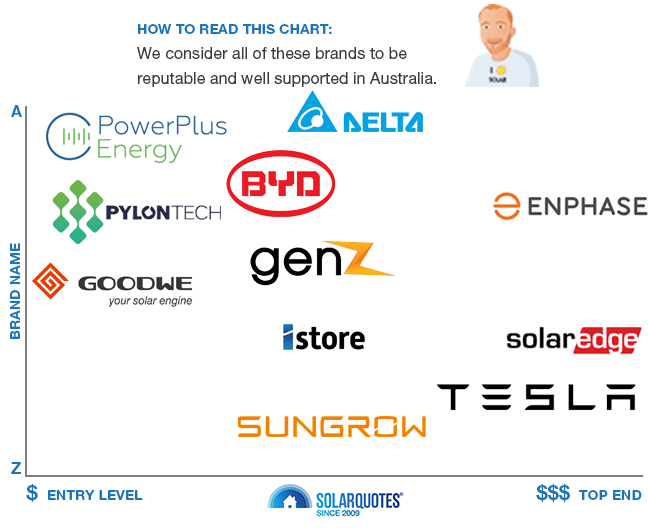

 RSS - Posts
RSS - Posts



How much do you allow for the cost of capital invested? The cost of capital of $10,000 over 10 years at 7% is $9,671.51. Over 20 years it is $28,696.84. If you add that in, does the payback period become infinity?
Hi Davyd
Many people aren’t as concerned about the bean counting as they are about security of supply. Returns vary on places and retail plans. It’s difficult to quantify the cost of a freezer full of food, composting it & shopping for more after a blackout… or wondering if the stuff stayed frozen anyway?
those people who still have a mortgage should look at the interest cost on the banks money they would use to buy batteries.
As for a freezer of food, if the power goes out for a day and the freezer is full of food it will still be solidly frozen, if it goes out for longer and if it has thawed then cook it, and eat or refreeze, no dramas at all. If its out for a week then the power company are obligated to pay some compensation. As for keeping the lights on then just have a few torches handy, much cheaper than a 10kwh battery
A battery is security against electricity price rises, against blackouts (I’m regional nsw so we get them all the time, so annoying), and also a way to save yourself thousands every year by eliminating your bills entirely and making a tidy return.
With Amber Smart Shift, assuming you care about a faster ROI and you adjust your usage patterns, you can both optimise your power usage and make a mint exploiting time of use tariffs. I generate enough even during winter to fully charge my powerwall (the odd day where I generate only a few kw I simply fill the battery from the grid at the lower price points. As I spent a lot of time and money drastically improving the thermal efficiency of our home, we don’t need to run the split system for heat and cool very often, and generally speaking we can run it for about 15 minutes (a mere 1.47kw power draw per hour). It only costs me 0.36kwh to quickly cool the house down during summer and it stays cool. The beauty is I can operate it remotely so I can take advantage of either my solar output or lower grid prices during the earlier afternoon to cool/heat so when I get home it’s comfortable and I don’t need to run high power draw devices.
The hot water is solar as well so even on low output day I can activate the booster remotely and either use cheaper grid power or the battery and then refill the battery during a later cheaper period. I’ve got everything on smart plugs to monitor so i know my average power draw atm in the evening is 0.35w per hour.
The last few weeks I made $300 on just one evening discharge on a very cold night. I only needed a small amount of power so I was able to use most of the battery to sell back to the grid. It then automatically refilled the battery for me after midnight for a few cents a kw.
It’s not going to make you the returns of an ETF, fixed deposit etc etc but if you don’t mind putting in the effort (you can make your own scripts and feed in historical data) then you can reach ROI in years.
It’s Simple Payback – cost of capital isn’t considered for the sake of the Youtube video.
But we cover cost of capital in our dedicated page on battery payback:
https://www.solarquotes.com.au/battery-storage/payback/#capital
Hi Finn,
As an interim to getting a new battery, I’ve read that it’s possible to use recycled EV batteries for home storage. We only use a couple of Kwhs at night and in the mornings so this would suit us.
Have you heard whether anyone is doing this in NSW I.e., converting used car EV batteries for home solar use, and if so, who?
Thanks.
It’s worth considering that the battery (or my case 2 x batteries) can be very useful at avoiding peak hour charges in TOU electricity rates.
Your table above does show this. Bear in mind often when you get solar installed, you are forced to get a smart meter (in NSW anyway) and then they force you onto a TOU tariff. I had no choice in the matter of moving to TOU and I wasn’t informed until after it was done.
I am getting smashed this winter due to minimal solar generation on wet days and night time electric heating – but in summer I had 2 days in 91 when I used any electricity from the grid in peak hours.
My peak rate is an eye watering 62.280c per kWh (Origin Go Solar) so if I can use battery stored solar for 20kWh of peak usage each summer afternoon/evening I am generating over $12 per day savings from that alone. In winter most days I can’t get enough solar to get me through the peak.
Hi John,
You’re just the use case for a battery.
https://www.solarquotes.com.au/blog/install-second-powerwall/
My favourite allows for unlimited solar capacity
https://www.solarquotes.com.au/blog/selectronic-sp-pro/
However you might get better value buying a larger battery that comes with a free car and no petrol bill.
https://www.solarquotes.com.au/blog/hoem-review/
I am not sure that you HAVE to go to time of use with a smart meter. You may well be misled into thinking that, or perhaps something has changed. Equally the call centre script may indeed say that, drafting error of course.
Just call me suspicious.
At worst you can contact the anit-discrimination Commissioner. You’d be amazed how often after I’ve been told a pack of lies, I then mention lodging a complaint with the a-DC and like magic the no-way you can becomes, ‘I think I can arrange an exception for you’.
This has happened with airlines, banks, health funds and utilities. Best one was ‘You can only change your credit card pin online & then receive a code on your (mobile) phone’.
For example did you know that under Federal Legislation you cannot be forced/required to receive notifications on a mobile phone – even though a certain bank tried to insist there was no choice? How can a blind, sight impaired person see a code on a mobile phone…
By (Federal) law any institution etc is required to offer an alternative.
I know that some power companies DO try to insist you have to go TOU. If they do then request them to provide you with a copy of the State Legislation that requires it.
RAM,
You are right TOU is not mandatory, but Energex in SE QLD do note flat-rate tariffs are no longer allowed when the meter is changed:
“A common trigger for a retailer to move you to a non-flat tariff is when you have installed solar, for new homes, or when your existing meter is replaced or upgraded to a smart (digital) meter. Under the network tariff rules approved by the Australian Energy Regulator, when a residential premises has a smart (digital) meter installed, the network tariff applied to that premises can no longer be the flat rate tariff (i.e. NTC8400 – see table below). It is not possible for the network tariff to be changed back to the flat rate tariff – it is up to your retailer which types of tariff they offer to their customers with smart (digital) meters.” https://www.energex.com.au/manage-your-energy/save-money-and-electricity/tariffs/residential-tariffs
So in SE Qld you now only have TOU or 2x different demand tariff options to chose from. By default you get put on ‘transitional demand’ – which is terrible for low use (solar) customers.
Energex note you can “contact your retailer and request they submit a tariff change request form” for you. I did this and was switched to TOU.
I’d argue Energy policy should require DNSP’s to look at usage at a premises before switching customers to a demand tariff. Demand tariffs are very poorly understood by consumers and many, many will be much worse off under them (if they cannot minimise park demand). Regulators should require DNSPs to put low-use households and businesses on TOU tariffs instead. Demand tariffs are not fit-for purpose for vulnerable households, but may be appropriate for sophisticated high-use customers, or those with batteries…
I’m getting a second powerwall soon, I’m loving the first and already made a mint with it via Amber Electric. It is 100% the most amazing thing providing you research the historical wholesale price trends and monitor it daily. You can write scripts to automate things yourself and they have smart shift if you prefer a more hands off approach. It is better to be 100% hands on because you can make some really crazy returns on battery discharge.
As I don’t tend to use much power, I am able to discharge most of my battery in the evenings, then I refill if needed after midnight when the wholesale price usually craters.
On many of the non stop rain and overcast days the past 2 weeks I have filled the battery after the meagre panel generation for 14-17c/kw most days then I’m discharging it back to the grid during evening peak demand. In one night I made $300 from an almost full discharge (I left enough to run the fridge and switched everything else off remotely while I went to bed).
When you can make these sorts of returns (I am looking at 1200 profit the past 5 months, plus the $1200 of electricity I no longer have to pay for (old bill was 2400 a year).
I think the biggest thing a solar battery makes you do is change your power habits. I gave away our dryer once I put the smart plugs everywhere. My wife was killing us running that energy vacuum. I switched our stove top and oven to gas, hot water is instant gas. One bottle lasts us 10 months ($14/month). No electric replacement I’ve calculated is cheaper that I’ve calculated so far. When you know how much power everything you have plugged in draws you start to consider subconsciously whether you actually need x number of light on or not, whether you truly need the aircon when you can just turn on a low energy electric fan. Or you put on a jumper or warm pants instead of turning the heater on.
Honestly I’ll probably put in at least 2 more powerwalls so we can use a bit more in the evenings but overall love it.
Hi Jacob,
Sounds like a great little project, aside from the gas part, which isn’t good for your health.
Behaviour change is the best thing solar has ever done for people if we’re being honest, but it can go both ways. Some people like yourself really economise once they have the tools, which is great. Others relax about the size of the bill and splurge consumption.
I hate to recommend the Zuccerburg empire, but it’s become ubiquitous and there’s some real value to be had here;
https://www.facebook.com/groups/MyEfficientElectricHome
My Efficient Electric Home has a great community of 110 000 like minded Australians who are ready and willing to offer ideas and valuable expertise on electrification.
Getting off gas is also a no brainer, so much so that the fossil gas industry is madly advertising cooking (2% of it’s sales) so you make an emotional connection, and they can keep charging for a gas connection.
Induction is cheaper, easier to clean and better for your health.
https://www.rewiringaustralia.org/
https://electrify2515.org/
Apropos the cheap shiny blue prismatic cells depicted. I’ve went and gone an done that, but it’s nerdy and has risks. You need to choose, install, and correctly configure an adequately rated BMS (Battery Management System) per bank, and that’s over $500 each for a good one. And you may need an (active) balancer as well, if it’s not integrated in the BMS. They have to be wired to every cell in each bank.
Attaching busbars to connect the cells is not without risk. Dropping a spanner across busbars can weld it in place, destroying the cells, and the arc flash can cause temporary blindness and skin burns. Covering exposed busbars during installation and afterwards is absolute minimum precautions, and full appropriate PPE is not cheap.
Then there’s the battery enclosure. Exposed terminals & busbars are no go.
It will fail inspection. One of the 48v boxed banks with included BMS is more manageable, though savings diminish, but Chinese risk remains if bought overseas. I bought mine from a Queensland reseller. At least there’s the prospect of some consumer law protection.
After you’ve configured battery chemistry, # of cells, cell (over/under)voltage limits, balance thresholds, (dis)charge current limits, and twenty other parameters, you’ll find yourself keeping an eye on cell voltages, discover they bounce about a bit much at high charge rates, so have to trim your sails there, for peace of mind. (You build it, you own it.. 😉
I’d venture to suggest they’re less than ideal for busy civilians, especially if the risk of longevity & performance disappointment would be too financially painful.
I’m receiving technical backup, beyond the installer’s knowledge base, from the inverter wholesaler, to improve system performance, but the batteries are my responsibility. Fortunately they’re good so far. Time will tell.
Eric, you make it looking as something very complicated but it is not. Dropping a spanner on contacts is bad, and it always was bad for all types of batteries. Still, no one scared to install/replace/use car battery.
“After you’ve configured battery chemistry, # of cells, cell (over/under)voltage limits, balance thresholds, (dis)charge current limits, and twenty other parameters…” – there is nothing to configure. There are only two types of chemistry widely available, and only one is suited for home battery by safety and (most important) price consideration. Number of cell is always the same – 16, as absolute majority of inverters are 48 volt. “Twenty other parameters” are already set in the BMS software and it is better not to change them.
The only important thing is to balance cells before you combine them in the pack. Single-cell charger solves this problem. And this is relevant only to “crazy” people who create their own battery packs.
Normal people buy ready-made packs. You just take two reasonably thick cables (use only calculator or follow pack manufacturer advice) and connect battery pack to the inverter/charger. That’s it. Don’t forget to update total battery size in the inverter setting.
Tim, just discharging my 46 kWh battery set at 1C (for which it is rated) is 900A at 52v. Apply a short circuit, and there’s a few thousand amps. A piffling car battery does not remotely compare.
Even my electrician wasn’t up to speed on the need for HRC fuses, and the inadequacy of the much used Mega and ANL fuses where fault current could be over 2,000A/6,000 A:
Fuse Type Current Ratings Interrupt Rating
————————————————————-
MIDI Fuses 23A to 200A 1 kA
MEGA Fuses 40A to 500A 2 kA
ANL Fuses 35A to 750A 6 kA
MRBF 30A to 300A 10 kA Marine Rated Battery Fuse
————————————————————-
https://www.solar-wind.co.uk/off-grid-power-blog/post/when-is-a-fuse-not-a-fuse.html
I’ve used HRC fuses with a 100 kA rupture capacity. They don’t break the bank. One difference between an amateur’s approach and engineering is the level of safety.
My customisation of cell overvoltage limits and (dis)charge currents etc. can be expected to add to longevity. And as my earlier post intimated, individual cell monitoring does too, as medium-high charge currents (100A into a 304 AH bank) can push a constipated cell to 3.65v. A temporary protective BMS disconnect avoids cell overstress, also lengthening life.
In-service cell balancing is essential to long battery life. It is provided in Zenaji’s LTO batteries, and reputable rack mount modules. Each of the 16-cell packs I bought were voltage matched to within 10 mV on delivery, but that is not quite SoC match, so especially when charged fast, active balancing above e.g. 3.45v is needed in the long term. That’s another parameter to set, so balancing stops in the flat part of the voltage curve, i.e. we only “Top Balance”.
Selectronic battery inverters support 120v banks, and 72v is also used. That’s at least 22S, so not “always 16”.The BMS I use goes to 24S.
This is your money, you do what you want.
LTO is overkill for home battery. LiFePo4 is the way to go – cheap and safe. For the price of LTO I can buy at least double capacity of LiFePo4 cells. LTO is not available as large cells, that makes design more complicated. What is the point?
Home battery never charge or discharge quickly. My inverter is 10kW, so the maximal I can have 200A split between 5 battery packs, that is 40A per pack for discharge (which never happens) and even less (much less) for charge. It is 0.1C and less.
My first battery pack is 9 years old already and it works as new. Battery cells were guaranteed for 2000 cycles at 80% DoD. However, charge and discharge are so low for home batteries, that longevity grows exponentially.
Cell balancing is included in all somewhat good BMS. All parameters are set by hardworking Chinese engineers and they are the same for all cells with the same chemistry. No need to invent the bicycle. Just open setting once, check that they are the same as recommended everywhere on the internet, and forget about them.
I said “majority of inverters”. Yes, you can get any configuration you want for extra money, it does not prove anything. Majority of battery packs are 16 cells 48 volt to match majority of inverters (if we talk about home batteries). Or, I would say “value for money” battery packs and inverters.
Does the Tesla back up all circuits in the house including when there is 3 phase supply and including three phase appliances?
Hi Grant,
NO. You can have 3 x powerwalls but they will not back up a 3ph synchronous load.
There’s so little demand from the 110v peasants in the US, Tesla doesn’t cater for 3 phase.
https://www.solarquotes.com.au/blog/3-phase-battery-backup/
https://www.solarquotes.com.au/blog/3-phase-battery-trap/
https://www.solarquotes.com.au/blog/three-batteries-3-phase/
https://support.solarquotes.com.au/hc/en-us/search?utf8=%E2%9C%93&query=Three+phase
$10,000 for 10kWh plus installation? Tell them they’re dreaming.
About 9 years ago I paid $11,000 for 20kWh. 2 years ago I expanded the system and got extra 30kWh for $9,000. Virtually $0 DIY installation. All batteries paid off even before I bought them, as getting grid connection was more expensive than building solar+battery system.
China noname rules. In fact, there are Chinese brand names you can trust. All batteries are made in China anyway. So, what is the point to pay 3 times more for the fancy sticker?
Nice work Timbo,
What’s the average and max kWh your house has consumed in 24h?
Do you have an EV?
I don’t know for sure how much I use electricity as it is free for me, so I don’t count. I have a mix of AC and DC coupled systems, it is a bit difficult to see consumption. I could calculate it but I see not need.
I try to use a lot electricity but most of it comes directly from the sun (14kW solar) and not from batteries. Typically batteries don’t go below 90% level (that is only 10% use). This week three days in a row were mostly cloudy and battery went to 50%. This is a parameter I always watch closely.
I have heated swimming pool with 31 degree all year around. Desalination unit – it uses a lot of electricity. All common luxuries – fridges, AC, induction cooktop, HWS, plus numerous pumps required for off-grid living. No EVs.
I guess EV will require larger system as it cannot be charged from solar panels directly – panels stay home when I drive away for work and sun does not shine when I get back.
You pay for the warranty and guarantee of quality & support for the duration of said warranty.
If you can DIY that’s great but you can’t do that for a grid connection and DIY electrical work is illegal in Australia if you aren’t qualified to the appropriate level.
You can save money going for cheaper battery brands but you are rolling the dice on whether they’ll still be around or even care about helping with issues down the road.
Batteries were cheaper in the past but due to global supply chain shortages, manufacturing bottlenecks and increasing demand we will see prices continue to surge the next 12 months.
This NSW $2400 rebate for new battery installs is going to inflate prices even more because installers will just increase the price and use the rebate to sell the batteries for “$2400 rebate will save you $$$” and post-rebate price will be the 2.4k less (so you’ll probably be paying 18-20k for a powerwall minus the rebate (so similar price as it is today out of pocket while the installers pocket the rebate).
It’s funny they try to incentivise battery adoption due to the extension of the coal fired power station but its going to just drive already short supply batteries up further…
Hi Jacob,
Governement incentives are always fraught with the spectre of waste but they’re at least doing something about uptake. While it might be fun to dump on “greedy installers” in reality the solar industry is distraught about this NSW announcement because it basically puts batteries on ice until November. Customers will just wait and there will be no sales 5 months.
Then right when the end of year STC incentives make solar busy anyway, AND the xmess rush is in full swing, there will be a wave of battery demand that’s difficult to meet.
We have been on our Solar journey in Melbourne since 2018, and with all of our savings we created a bank account which now sits at $34,000. This is 53% of our total outlay. When we started there weren’t rebates. our 1st rebate was on the 3rd Powerwall 2. We were part pensioners then and our increased Aged Pension savings, we banked. Now full pension and enjoying 13% ROI on the purchases.
Rate increases have been minimal because we moved to ToU last year. Using Tesla’s scheduling and NetZero Automation has helped immensely. We have only used 36kWh Peak in 12 months. Half of that was StormWatch kicking in recently. We let that topup the PW2’s because it was a first.
There’s no option to add a file, which was a graph showing our journey with our billing with the capital expenditures. Our Power bill has gone $4,700pa in 2018 to $288pa in 2024. We will have the money in the bank when the PW2’s get to their useby date. One of the PW2’s is on Tesla’s annual watch list because they contacted us in 2022 telling us of the degragation
Hi Colin,
That’s a brilliant breakdown.
Please feel free to send us any images, table or spreadsheet and we might ba able to turn it into an article to explain your success to everyone.
Cheers
[email protected]
“If you have a tricky install, with long cable runs or extra components (like bollards) needed, this will be closer to $3,000.”
Are the bollards shown in the picture (below the statement referred above) purely dependent on the strength of the seemingly thin base flange and four relatively small fasteners fixed to the concrete to resist bumps/knocks from vehicles? Based on the photo provided, it looks to me like they wouldn’t resist much.
In my experience, an effective bollard for resisting impacts from motor vehicles while protecting sensitive equipment requires the bollard pipe with a heavy wall thickness and sufficient outside diameter extending through a core hole drilled into the concrete slab to a depth of at least the outside diameter of the bollard pipe (preferably 1.5D), the tube is then bonded to the concrete slab and the bollard tube is filled with concrete. A thick flange with a full heavy circumferential weld also helps. The flange fasteners stabilize the bollard while the bolding process sets but usually don’t provide much extra strength.
Hi Geoff,
I think most bollards are box ticking and end up bring decorative compared to what you’re talking about. Some installers use a frame attached to the wall with supplementary posts to the floor, but again this will only fend off very minor collisions. They’re better than nothing.
How does the spread of your power usage over the 24 hour day affect the go/no go decision for a battery? I probably consume more power during daylight hours than after dark, so I have always considered a battery unlikely to fit my needs. I have a 6.6Kw PV rooftop system that has proved beneficial for a house of 5 adults, but I am always looking for ways to do better.
Hi Tom,
TOU pricing varies, as does your consumption patterns of course but a battery has use for shifting solar into the evening.
What’s likely most valuable are a few links here; I hate to recommend the Zuccerburg empire but
https://www.facebook.com/groups/MyEfficientElectricHome
My Efficient Electric Home has a great community of 110 000 like minded Australians who are ready and willing to offer ideas and valuable expertise on electrification.
Getting off gas is also a no brainer. It’s cheaper, easier to clean and better for your health.
https://www.rewiringaustralia.org/
https://electrify2515.org/
I use this comparison service. Pay your subscription and the promise they’ll save you more than it costs.
Set up automatic forwarding of your bills and they’ll let you know when better deals crop up.
https://www.billhero.com.au/
Full disclosure, if somebody signs up using the code below, both they and myself will get an additional two months of Bill Hero for free.
bh11811-nmp1668684689
Thanks Anthony – some reading ahead.
I have a question. Hope I’m in the right section of the blog.
There seems to be a broad push to put most domestic residences onto new smart meters and onto TOU tariffs they bring.
Is it practical to put in a battery WITHOUT solar panels, and use the cheap TOU grid power available during the day and after midnight to charge the battery, and use the battery in the evening and morning peaks to offset the high TOU peak tariffs.
Would that approach make economic sense?
Hi Rob,
Try this article. Cheers
https://www.solarquotes.com.au/blog/install-second-powerwall/
Many thanks, useful reading. In my situation it looks financially marginal until I’m forced to change to a TOU tariff. I’m a light user of power except during winter (heating) and I’m currently on a good flat rate tariff. I’m probably better off spending on getting my old house better insulated and sealed. Thank you.
Hi Rob,
Efficiency is always a winner and there’s lots of help available here :
https://www.facebook.com/groups/996387660405677
Hello, just received latest deal from AGL on 15/8/24 with new additional $300 discount. So $11950 for Tesla Powerwall 2, plus battery backup.
I am still worried as many reports of powerwall failure and Tesla replacing with old batteries
Mark.. I wouldn’t worry about that. We have 3 Powerwall 2 batteries and one of them is a failing battery. What you’re hearing, is about a batch of PW2’s manufactured around May-Aug 2019, ours is July’19, It has degraded 26% in 4 years. The warranty is 30% at 10 years. My other two batteries, now 3 years old are degrading what I call normal at 2%pa. We are a heavy user in Melbourne and charge them to 100% and discharge to 20% every day through the colder months. Many others in the Australian Tesla FB Group post that they still have 101% remaining. The way the PW2’s are designed there’s 5% capacity you don’t see which is used for its temperature control etc. From my reading that’s now about 10%. You still have your 13,500Wh available. The Tesla warranty allows them a choice of replacement, that includes a refurbished PW2. Back to your quotation, that’s a good price if it includes the Gateway box.
Terrific Colin, many thanks for your detailed info!